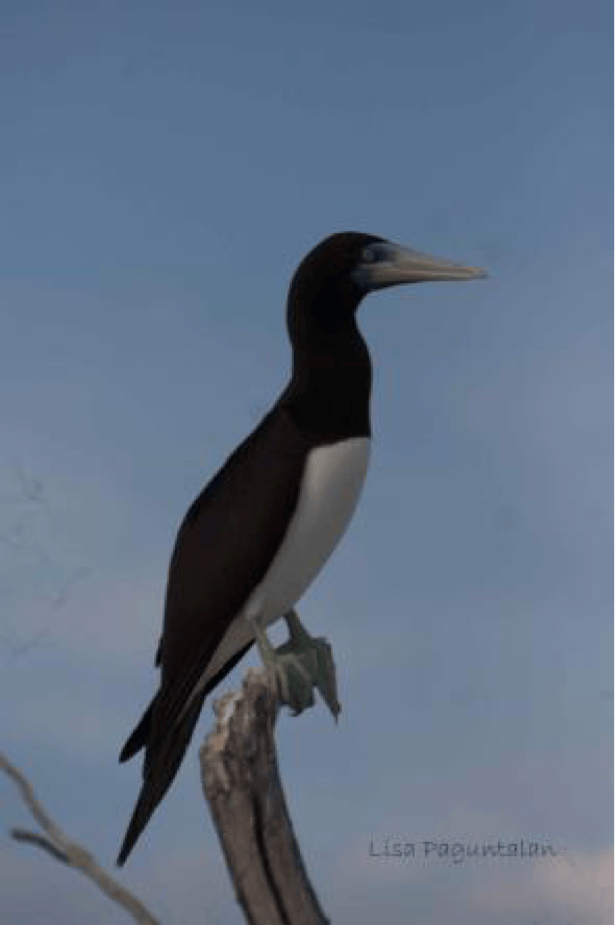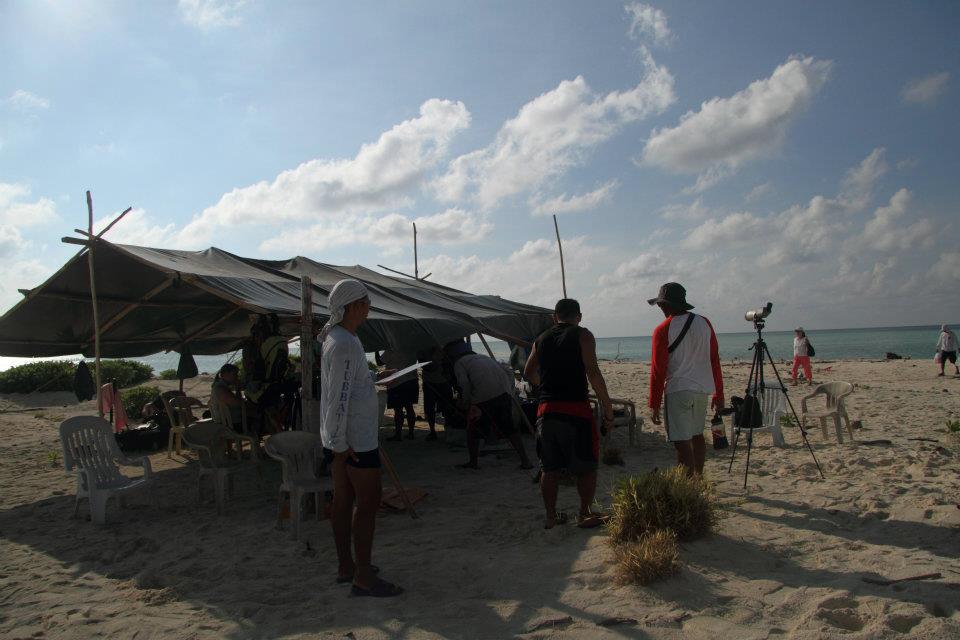The Tubbataha Reefs are one of the few places in the Philippines where the wildlife are given top priority. Lisa Paguntalan shares her amazing experiences during the annual seabird survey at this beautiful and successful wildlife refuge.
space
A Lifer Dream Come True: Tubbataha Seabird Count
by Lisa J. Paguntalan
Director for Field Operations
Philippines Biodiversity Conservation Foundation Inc.
Simply enchanting! Breathtaking! Picturesque! Expensive! These are just a few words used in describing Tubbataha Reefs. The name itself sounds like an exotic place in a far away land. Most of us know it as the ultimate place for divers. For it only means two things: extensive sand bars and seabirds!! Tubbataha contains two small islets situated on the rim of atolls. The South Islet measures less than 3000 square meters while the North Islet measures some 10,000 square meters. Both Islets represent one of the last intact habitats in the Philippines for seabird breeding colonies.


Situated right in the middle of the Sulu Sea, bordered by Negros Island in the east and Palawan Island in the west, the Tubbataha Reefs are one of a kind. It’s a UNESCO World Heritage Site and the only pure marine World Heritage Site in Southeast Asia. It belongs in the Top Five best diving sites in the world. It is a Protected Area and an important site for marine wildlife and seabirds. This is one place in the Philippines where one can positively see the endangered Christmas Island Frigatebird Fregata andrewsi. It is also the only known place for the breeding population of the endemic subspecies of Black Noddy Anous minutus worcesteri. It is these two last points that make Tubbataha extra special.
Special Birds of Tubbataha
A total of seven species of seabirds breeds in the Park. The North Islet is also called the Bird Island as it is just teeming with seabirds and migratory birds. The South Islet is also called “parola” which means lighthouse. There were at least 99 species of birds including residents and migrants. Among those species of importance is the Chinese Egret. Bird Islet also harbors the largest known breeding colony of Great Crested Tern Sterna fuscata and Sooty Tern Sterna bergii in the Philippines. It also has breeding population of Brown Boobies Sula leucogaster, Red-footed Boobies Sula sula, Brown Noddy Anous stolidus and the endemic subspecies of Black Noddy Anous minutus worcesteri.

Tubbataha Seabird Monitoring Group
The months of March, April, and May are the only time of the year when outsiders are allowed on these vulnerable islets. It has been years since I was first invited to join the annual Tubbataha seabird monitoring survey. It was sort of a reunion when I met with the volunteer group as I know some of the key people. A formal introductory meeting in the Tubbataha Management Office in Puerto was facilitated by seabird specialist and Danish ornithologist Arne Jensen with the Tubbataha Management Office (TMO) and Protected Area Superintendent Angelique Songco. We also met with WWF Philippines Project Manager Marivel Dygico, WWF Communications and Media Manager Gregg Yan, Maia Melencio, Dr. Teri Aquino and TMO Rangers Segundo Conales, Glenn Redondo, Mark Dagsa, Roy Magbanua and Dennis Favila.
We were told that we will leave that night, on board MV Navorca – the marine research vessel of the World Wildlife Fund – Philippines. I was grinning ear-to-ear as this was a different experience for me. It was my first official seabird survey, my second visit to Tubbataha, my first field experience with Arne Jensen and the Tubbataha team and my first actual field work with WWF – Philippines. A lot of thoughts crossed my mind. How were we going to spend the next five days together in one boat or in a tiny island shared with thousands of birds? I had a lot of questions. Will the weather cooperate? What would it be like to count nesting birds? Will I see a lifer during the trip? My! This should be really exciting!
Getting Ready to Work
How do you count thousands of birds composed of at least eight species? I was all ears listening to Arne and the group discussing the methods and field techniques. As each task was explained, a team member would volunteer to do it. I was just waiting for what bird would I count. Soon no choice was left but the Black and Brown Noddy nests and eggs and to work with Arne. I heard lots of interesting stories about how Arne works. They said that only the fittest should dare volunteer to stand right next to him. That’s the assignment I got. My! This would be quite a challenge and exciting as well. I had not worked with Arne in the field but I have worked with people of the same caliber. So this should not be any different.


Close Encounter with Bobbies and Tern
My final task was to count Sooty Terns, Black and Brown Noddy nests and eggs. I was excited as this seemed challenging. Yes! The count was indeed tricky as both Crested and Sooty terns were nesting right beside each other with almost identical eggs. Only a trained eye and a lot of experience will enable one to breeze through the count without difficulty. Sooty terns prefer to nest close to grasses and vegetation while Great Crested terns lay their eggs on exposed areas e.g. sand or on soil. But when options are limited, both birds nest on sandy areas on the beach, neatly arranging the eggs almost equally spaced apart from each other. This is where it is really challenging to know which eggs belong to what species.
I set out on the task tagging along with the well-trained park ranger Seconds (his true name is Segundo). We started counting around 9:00AM and we were still halfway through by the time noon came. I was so overwhelmed with the sheer numbers of the Sooty terns. How can there be so many birds in a tiny island? Amazing that they could fit and find their place to lay an egg.

In between counts, I took time to embrace the overwhelming experience of just being with birds in an isolated islet surrounded by pristine water teeming with marine wildlife. I could not help but feel immensely lucky to have a close encounter with these Jurassic-looking seabirds. The experience was just beyond words. By the time we took a break, it was already noon. The heat was so intense that we rushed straight into the water just to cool us down. My! My! A line of Green Sea Turtles, all 18 of them were heading towards us. The nearest one was just a meter away from me. The experience was just too good to miss. We then spent the next 20 minutes swimming with the turtles. We counted more than three thousand nests and eggs of Sooty Terns in Bird Islet.
Life in the Field
We had a choice whether to sleep on the boat or stay on the island. We chose to stay on the island. One of the memorable times while sleeping under the star-speckled sky overwhelmed by the huge, bright moon was the close encounter with the crabs. It’s funny how such a small thing as a crab can create so much drama in one night. As we lay down on our sleeping bags, tired from counting birds all day under the searing sun, I heard this scratchy noise against the tarpaulin. At first there was just one crab, then two more and then they just seemed to intensify. Everybody was too tired to bother with the all the crabs scratching at the tarpaulin. We all fell asleep the moment we hit our sleeping bags. Then the silence was suddenly broken with one camper crying out and frantically throwing his hands in air! This was followed by a soft thud as whatever was thrown hit something before it fell onto the sand. After seeing that everything seemed okay, we settled once again in our sleeping bags. Just when I thought everyone had finally fallen asleep, someone cried out loud! A crab bit a finger or toe! This went on for some time until I got so used to this event that I finally fell asleep.
Unsung Heroes of Tubbataha
What we have in Tubbataha would not be there if not for the passion and dedication of a number of local unsung heroes. Leading the group is the Protected Areas Superintendent Angelique Songco of the Tubbataha Management Office supported by the Park Rangers Segundo Conales, Glenn Redondo, Mark Dagsa, Roy Magbanua and Dennis Favila and her staff. If not for this brave and sweet lady, her team of park rangers and dedicated staff rallying for support to protect and conserve Tubbataha, we would not be enjoying what we have now. Equally noted is also the undying support of Dr. Teri Aquino and Arne Jensen with the WWF Project Manager Marivel Dygico and her staff. I could also not forget the first class treatment and service of the MV Navorca crew and staff of WWF-Philippines.

One of the greatest achievements of the group is the recovery of the populations of seabirds in the area. From only a few thousand individuals in 1992, the seabird population now reached 30 thousand individuals. It’s an amazing figure for such a small group of locals who risked their life protecting wildlife. Kudos to the Tubbataha Management Office and the Tubbataha Park Rangers! Keep up the good conservation job of the wonderful Tubbataha Reefs Natural Park!
[slideshow]











fantastic and amazing tita Liz…great! feels like ive been in the place reading your article…a dream come true for me..cheers, aL_vir
Greetings….I would like to inquiry regarding a flock of Roseate tern now breeding at an islet of Labuan Island North Borneo and one of it has a band or ringing at left feet (a silver banded). Any possibility its from your nearby island.? Please response ASAP via cepiauctambaguz@gmail.com.TQVM for your anticipation.
Best regatds
NORALIP